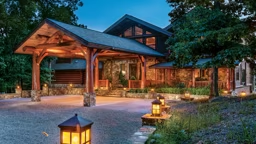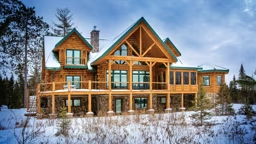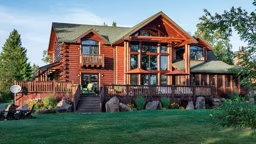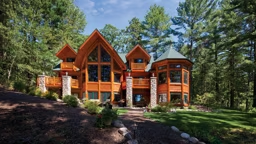
It was the twisted branch the builder mounted over the front entry that inspired Bill Fey, the original owner of the bed-and-breakfast, to name his business The Bentwood Inn. Built in 1995 in Jackson Hole, Wyoming, the inn incorporates massive 200-year-old logs harvested from Yellowstone National Park after the 1988 fire. According to Keith Sproule, the Bentwood’s managing director, the National Park Service found a good location at the junction where the fire had burned and some large stands of pine remained. “They wanted to establish an interpretive area for visitors to be able to compare and contrast the impact of the fire and regeneration against a stand that had survived,” Sproule says. “The logs that were put up for auction had actually survived the fire, but the heat had stunted them so they wouldn’t have continued to survive. Consequently, they were harvested by the Park Service and sold.”
Some of the larger logs are structural, like the beams and the 20-inch-diameter posts supporting the roof in the great room. Much of the structure is chinked, half-log siding inside and out. “The thickness of the half-logs is exceptional,” says Sproule, “and their size and the chinking not only contribute to the ambience, but to the quiet of the inn as well.”
Sproule and several partners purchased the Bentwood in 2007 and have operated it ever since. When we arrived on a cold, rainy September day, innkeeper Lee Clukey greeted us and ushered us into the great room, where a crackling fire warmed us up. Clukey and his wife, Deborah, came to the Bentwood last spring after selling their award-winning bed-and-breakfast in Ojai, California.
Frommer’s Travel Guide calls the Bentwood “an architectural marvel.” The 6,000-square-foot inn is a two-story building with interesting angles, three separate rooflines, plus more shed roofs over ground-floor patios. It’s obvious the logs have been stressed, but their imperfections add character, and most guests are impressed that they were repurposed rather than destroyed.
Inside, a three-story river rock fireplace soars to the great room ceiling, serving as a focal point and gathering place for guests. Swapping experiences with two other couples, from Texas and New Jersey, was one of the most enjoyable aspects of our stay at the Bentwood.
According to Deborah Clukey, whitewater rafting, hot-air ballooning, fly-fishing and wildlife expeditions are especially popular during the summer; in winter, most guests enjoy downhill and cross-country skiing and snowmobiling.
Sproule likes to describe the Bentwood as “an iconic log lodge,” adding that the partners’ vision in purchasing it was “to craft a conscious balance between luxury and adventure, healthy food and sumptuous celebration and outstanding hospitality in a valley that offers world-class recreation.” In keeping with the environmental emphasis in the Jackson Hole area, the inn is a member of 1% for The Tetons, a private-sector initiative comprising local businesses committed to donating 1 percent of their gross receipts to support environmental projects in the valley.
Since only 3 percent of Jackson Hole is available for development — the remainder makes up two national parks, three designated wilderness areas, national and state forests, Bureau of Land Management land, the National Elk Refuge and several private conservation areas — hotel construction in the valley has grown denser. Sproule believes the Bentwood may be the last of its type of lodging in the area.
Nestled on three acres, a stone’s throw away from the Snake River and just down the road from the south entrance to Grand Teton National Park, it offers seclusion to guests seeking a sense of getting away from it all. In fact, Lee Clukey says moose and elk often wander through the grounds. The structure itself is carefully landscaped with neat perennial beds surrounding it, cottonwoods, pine and willows nearby, and window boxes and containers of flowers at the entry and on the patios.
Our suite was cozy and comfortable, featuring two king-size beds and a spacious bathroom with a roomy shower. Each of the inn’s five guest suites has a gas fireplace, a flat-screen cable TV, wireless Internet and a private porch or balcony. Four have jetted tubs. Each is distinctively decorated. Guests can select from the handicapped-accessible Cowboy Room, with a private entrance and cozy window seat; the Cabin Room, with sunrise-facing balcony; the Bunkhouse Room, whose third-story loft has twin beds and a skylight for star-gazing; the Indian Paintbrush Room, decorated in Native American ceremonial masks; and the Wildflower Room, which boasts a bay window and garden access.
In the morning, we savored a buffet breakfast of fresh mixed fruit, juice, coffee, scrambled eggs, bacon, sausage, banana bread, corn muffins and delicious baked pecan French toast. The dining room is cheery with its bright red chairs and decor in a western motif. Bright sunshine streamed through the windows, and the room was filled with lively conversation. We hated to say goodbye.






_11868_2023-06-01_16-13-256x288.avif)




